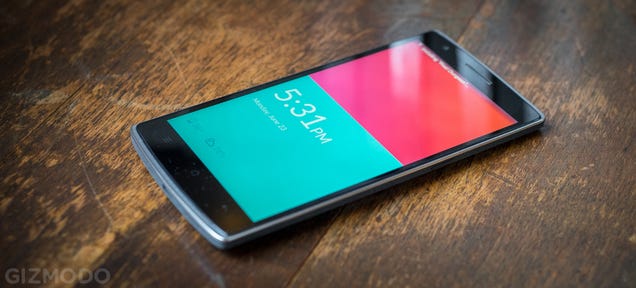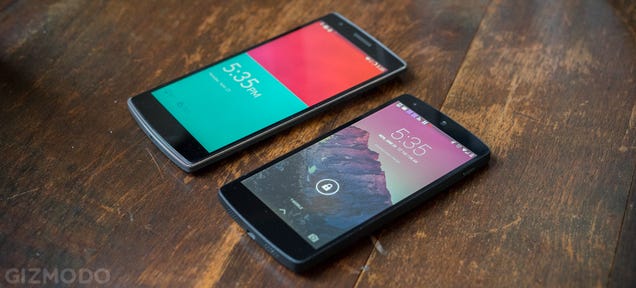
OnePlus One is an Chinese smartphone and was launched on 23 April 2014 for a price tag of $299 and $349 for the 16 GB and 64 GB models respectively.The OnePlus One runs a custom version of CyanogenMod, named 11S, based on Android 4.4.2 KitKat initially, then upgradable to 4.4.4 KitKat over-the-air. It’s a self-styled “flagship killer” phone and its sale was limited to invite only customers until now. It is rumored that it will open its sale to everyone from late of October.
Well it is a sign of threat to smartphone dictators like Samsung and Sony because of its challenging specs and features. For those who are thinking why ?, it is a high-quality, $300 dollar off-contract phone that runs CyanogenMod—a modded version of Android that’s popular with tinkerers—out of the box. A Nexus in everything but name. A 2.5 GHz Snapdragon 801-driven beast with a 5.5-inch, ~400 PPI screen, and a hunky 3100 mAh battery.
Design
From the second you lay eyes/fingers on the OnePlus One, you can tell it’s a high-quality device, almost impossibly so for the $300 price tag. It’s got a solid sort of heft to it, and the screen is raised just slightly over the silver edges, which gives you a fun surface to run your fingers around when you’re nervous. It also looks great.
 EXPAND
EXPAND
On the back, instead of opting for metal, your standard soft-touch plastic, or something glossy and cheap feeling, the OnePlus One we tested (“Sandstone Black”) has a fabric-y sort of texture. It doesn’t have any pull to it, and I’m inclined to think it’s just a strangely rough sort of plastic, but it feels like the inside of a tablet cover, the part that sits against the screen when it’s closed up. It’s a unique and strange but not entirely unwelcome material. It feels like it’ll get dirty quick—like you can’t set it down for fear that it’ll get greasy and stained—but after over a week of use it still looks great. It held up damn admirably to some time on my heinously unclean kitchen counter.
Performance
Of course it helps that the hardware underneath that custom OS just screams. The OnePlus One rocks a 2.5GHz Snapdragon 801—the fastest lil phone chip out there right now—and backs it up with 3GB of RAM. The result is a phone that almost never stutters, whether you’re just zooming around the homescreen or playing some Hitman Go. I never ran into any performance issues except for a little freakout where Snapchat was freezing up, but I’m pretty sure that was Snapchat’s fault.
With a serious engine under the hood, and that big beautiful display to run, battery life is a concern. Luckily the One’s beefy 3100 mAh battery packs enough juice to get you through the day.
 EXPAND
EXPAND
The only catch is that the One will really sip juice if you try to charge it with an underpowered charger. When I attached it to the same (random) charger that I use to charge my Nexus 5, I woke up to find that it had only gone from 10 percent to 75 percent in the 6 hours I had been sleeping. Though when you use the presumably more capable (and damn stylish) charger the One actually comes with, charge times are much more reasonable.
Camera
Okay, the OnePlus One’s camera is not great, but it’s not a total slouch either. The 13MP shooter performs pretty well in daylight, but less so in the dark of the night.
All that said, this was using the stock Camera app. The results once you boot up the Cyanogenmod camera app (which honestly I managed to forget about almost entirely) get a fair bit better. The stabilization improves, and the low light performance is way less of a joke. It also helps that the Cyanogenmod camera has a fully customizable interface, so you can move the buttons around to the best on-screen position that will keep your fingers out of the way of the camera on the back. And you’ve got options like burst fire, and HDR in there as well.
Using the right app brings the One’s camera a lot closer to par, but it’s not a feature you’d want to lead with. For a $300 phone, though, it’s hard to complain. And it’s still better than the Nexus 5 if not by a whole lot.
OnePlus One detailed specifications
| Release date | April 2014 |
| Form factor | Touchscreen |
| Dimensions (mm) | 152.90 x 75.90 x 8.90 |
| Weight (g) | 162.00 |
| Battery capacity (mAh) | 3100 |
| Removable battery | No |
| Colours | Sandstone Black, Silk White |
| SAR value | NA |
| Screen size (inches) | 5.50 |
| Touchscreen | Yes |
| Touchscreen type | Capacitive |
| Resolution | 1080×1920 pixels |
| Pixels per inch (PPI) | 401 |
| Colours | 16M |
| Processor | 2.5GHz quad-core |
| Processor make | Qualcomm Snapdragon 801 |
| RAM | 3GB |
| Internal storage | 16GB |
| Rear camera | 13-megapixel |
| Flash | Yes |
| Front camera | 5-megapixel |
| Operating System | CyanogenMod 11S |
| Java support | Yes |
| Browser supports Flash | Yes |
| Wi-Fi | Yes |
| Wi-Fi standards supported | 802.11 a/ b/ g/ n/ ac |
| GPS | Yes |
| Bluetooth | Yes, v 4.00 |
| NFC | Yes |
| Infrared | No |
| DLNA | No |
| Wi-Fi Direct | No |
| MHL Out | No |
| HDMI | No |
| Headphones | 3.5mm |
| FM | No |
| USB | Micro-USB |
| Charging via Micro-USB | Yes |
| Proprietary charging connector | No |
| Proprietary data connector | No |
| Number of SIMs | 1 |
| SIM Type | Micro-SIM |
| GSM/ CDMA | GSM |
| 3G | Yes |
| Compass/ Magnetometer | Yes |
| Proximity sensor | Yes |
| Accelerometer | Yes |
| Ambient light sensor | Yes |
| Gyroscope | Yes |
| Barometer | No |
| Temperature sensor | No |

